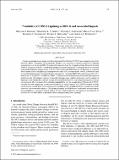| dc.contributor.author | Koshak, William J. | |
| dc.contributor.author | Cummins, Kenneth L. | |
| dc.contributor.author | Buechler, Dennis E. | |
| dc.contributor.author | Vant-Hull, Brian | |
| dc.contributor.author | Blakeslee, Richard J. | |
| dc.contributor.author | Williams, Earle R. | |
| dc.contributor.author | Peterson, Harold S. | |
| dc.date.accessioned | 2015-06-30T15:01:47Z | |
| dc.date.available | 2015-06-30T15:01:47Z | |
| dc.date.issued | 2015-01 | |
| dc.date.submitted | 2014-09 | |
| dc.identifier.issn | 1558-8424 | |
| dc.identifier.issn | 1558-8432 | |
| dc.identifier.uri | http://hdl.handle.net/1721.1/97578 | |
| dc.description.abstract | Changes in lightning characteristics over the conterminous United States (CONUS) are examined to support the National Climate Assessment (NCA) program. Details of the variability of cloud-to-ground (CG) lightning characteristics over the decade 2003–12 are provided using data from the National Lightning Detection Network (NLDN). Changes in total (CG + cloud flash) lightning across part of the CONUS during the decade are provided using satellite Lightning Imaging Sensor (LIS) data. The variations in NLDN-derived CG lightning are compared with available statistics on lightning-caused impacts to various U.S. economic sectors. Overall, a downward trend in total CG lightning count is found for the decadal period; the 5-yr mean NLDN CG count decreased by 12.8% from 25 204 345.8 (2003–07) to 21 986 578.8 (2008–12). There is a slow upward trend in the fraction and number of positive-polarity CG lightning, however. Associated lightning-caused fatalities and injuries, and the number of lightning-caused wildland fires and burn acreage also trended downward, but crop and personal-property damage costs increased. The 5-yr mean LIS total lightning changed little over the decadal period. Whereas the CONUS-averaged dry-bulb temperature trended upward during the analysis period, the CONUS-averaged wet-bulb temperature (a variable that is better correlated with lightning activity) trended downward. A simple linear model shows that climate-induced changes in CG lightning frequency would likely have a substantial and direct impact on humankind (e.g., a long-term upward trend of 1°C in wet-bulb temperature corresponds to approximately 14 fatalities and over $367 million in personal-property damage resulting from lightning). | en_US |
| dc.language.iso | en_US | |
| dc.publisher | American Meteorological Society | en_US |
| dc.relation.isversionof | http://dx.doi.org/10.1175/jamc-d-14-0072.1 | en_US |
| dc.rights | Article is made available in accordance with the publisher's policy and may be subject to US copyright law. Please refer to the publisher's site for terms of use. | en_US |
| dc.source | American Meteorological Society | en_US |
| dc.title | Variability of CONUS Lightning in 2003–12 and Associated Impacts | en_US |
| dc.type | Article | en_US |
| dc.identifier.citation | Koshak, William J., Kenneth L. Cummins, Dennis E. Buechler, Brian Vant-Hull, Richard J. Blakeslee, Earle R. Williams, and Harold S. Peterson. “Variability of CONUS Lightning in 2003–12 and Associated Impacts.” J. Appl. Meteor. Climatol. 54, no. 1 (January 2015): 15–41. © 2015 American Meteorological Society | en_US |
| dc.contributor.department | Massachusetts Institute of Technology. Department of Civil and Environmental Engineering | en_US |
| dc.contributor.mitauthor | Williams, Earle R. | en_US |
| dc.relation.journal | Journal of Applied Meteorology and Climatology | en_US |
| dc.eprint.version | Final published version | en_US |
| dc.type.uri | http://purl.org/eprint/type/JournalArticle | en_US |
| eprint.status | http://purl.org/eprint/status/PeerReviewed | en_US |
| dspace.orderedauthors | Koshak, William J.; Cummins, Kenneth L.; Buechler, Dennis E.; Vant-Hull, Brian; Blakeslee, Richard J.; Williams, Earle R.; Peterson, Harold S. | en_US |
| mit.license | PUBLISHER_POLICY | en_US |
| mit.metadata.status | Complete | |
